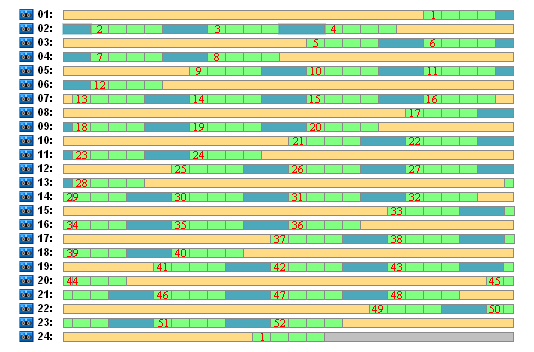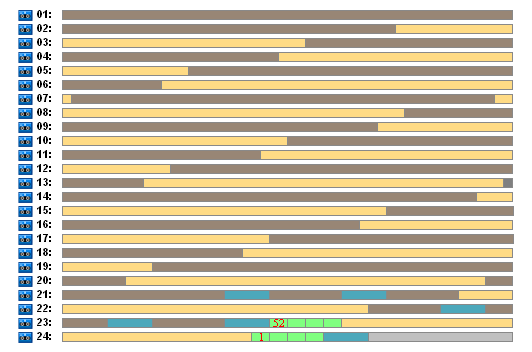Suppose, the backup plan has the following tape options:
Imagine the first backup operation is scheduled on Friday 1st of January. On that day at 11:00 PM the first full backup (320 Gb on the tape whose size is 400 Gb) is created. As the Use a separate tape set option is selected, the currently mounted tape is ejected (if it is not a free tape). Then a free tape is loaded especially for backing up the data. The tape is marked with number 01 in the figure below. In accordance with the legend described in the Case to analyze section, the full data backup is displayed as an orange rectangle in the figure.
The specified GFS backup scheme settings force the data to be backed up on Workdays only, so the next backup is created at the same time (11:00 PM) on Monday 4th of January. This backup is an incremental one (16 Gb) that is written onto the same tape 01, because the Always use a free tape: For each incremental backup option is cleared. The backup is drawn as a green rectangle in the figure.
![]()
The next three incremental backups are written onto tape 01 on 5th, 6th and 7th of January. As a result the free space on the tape is only 16 Gb at the moment.
On 8th of January the data differential backup (40 Gb) is recorded onto the same tape 01, as the Always use a free tape: For each differential backup option is cleared. However the tape reached the end after the first 16 Gb of the backup is written. Then the tape is dismounted and ejected from the drive into a slot by the loader. Further, a free tape is loaded into the same drive and mounted, and then the backup (last 24 Gb) is continued onto the beginning of the new tape.
The next figure demonstrates the data backup archive at the moment. The differential backup is drawn as a blue rectangle in the figure. Number 1 in the green rectangle marks the incremental backup created on Monday of the 1st week of the year.
![]()
Then the following backups are written onto tape 02:
The next full backup (320 Gb) should be written on Friday of the 4th week. However tape 02 has only 104 Gb of free space at the moment. So after the tape reaches the end, the recording continues from the beginning of free tape 03.

Keep in mind, that the Cleanup task is launched after each backup operation for the GFS scheme. This task deletes all the outdated backups. The next figure shows dark-gray rectangles instead of the backups deleted up to the current time.

Physically the deleted backups are still on the tapes; however information about the backups is deleted from the storage node database.
Below, the figure shows the deleted backups as actual, but demonstrates tape usage during the whole year for the GFS backup scheme in combination with the specified tape options. A number in the green rectangle marks an incremental backup created on Monday of the corresponding week of the year.

Tape usage during the first year
The next figure shows the actual usage of the tapes with free space instead of the deleted backups on the first Friday of the following year. At the time the differential backup (blue rectangle) is written onto tape 24.

The full backup stored on tape 01 is deleted after the next full backup is created onto both tapes 23 and 24 on Friday of the 52nd week. As all backups of tape 01 have been deleted, the tape is considered as free and can be reused.
Further analysis of the example proves that the maximal number of tapes required to store the data backups is 25 tapes. This maximum occurs on the 16th week of the following year.
The above mentioned figures show that a data recovery requires one or two tapes for a full backup, two or three tapes for a differential backup, and one, two or three tapes for an incremental backup.
For example, if we need to recover data from a backup created on Monday of the 52nd week, the task will require the following tapes:
The example reveals the following shortcomings of the scheme combination with the specified tape options: